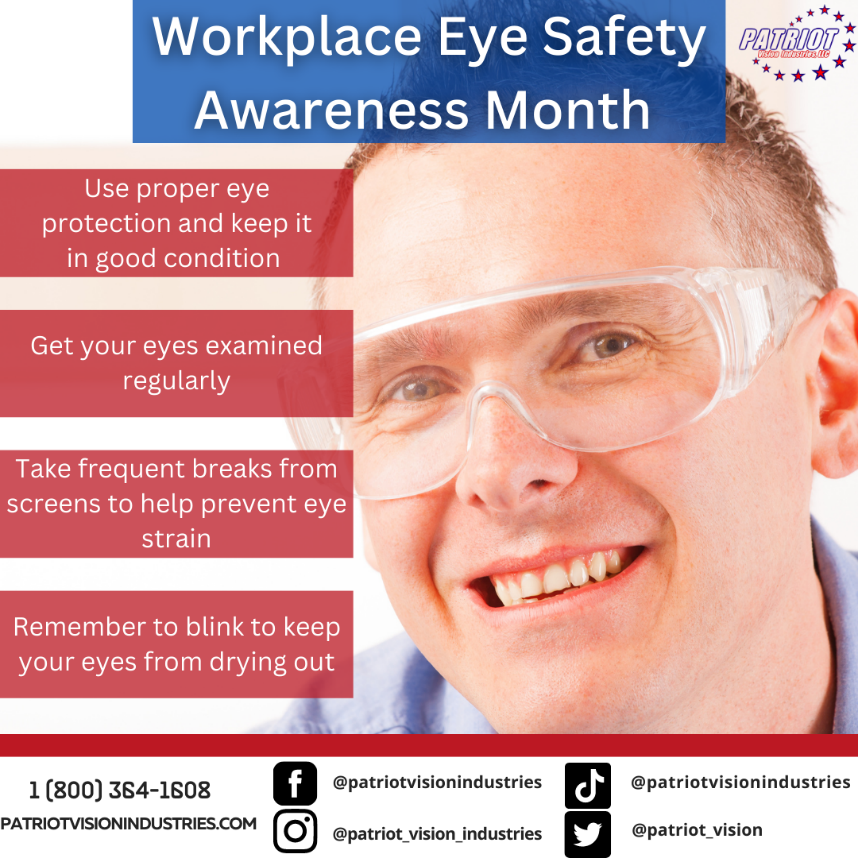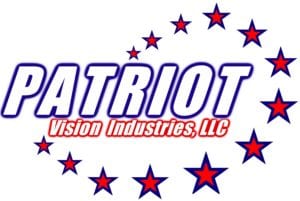
March is Workplace Eye Safety Awareness Month

(An image of a man wearing protective eye wear is captured. Text reading, "workplace eye safety awareness month. Use proper eye protection and keep it in good condition. Get your eyes examined regularly. Take frequent breaks from screens to help prevent eye strain. Remember to blink to keep your eyes from drying out." is displayed within the graphic. The Patriot Vision Industries phone number, website and social media handles are located across the bottom. The Patriot Vision Industries logo is in the top right corner.)
The eyes are one of the most vulnerable parts of the body, and they can be easily injured if proper precautions are not taken. Workplace eye injuries can range from minor irritations to severe and permanent damage, including blindness. That is why March is Workplace Eye Safety Awareness Month is an annual observance that promotes eye safety in the workplace.
The importance of workplace eye safety cannot be overstated. According to Washington Eye Physicians and Surgeons, there are more than 2,000 on-the-job eye injuries every day in the U.S. that required time away from work. These injuries can be caused by a variety of hazards, including flying debris, chemicals, and radiation. In addition to the physical pain and suffering that these injuries can cause, they can also have a significant financial impact on both the worker and the employer. Workers who are injured on the job may be entitled to compensation for medical expenses and lost wages, and employers may be held liable for failing to provide a safe work environment.
One of the most important steps in preventing workplace eye injuries is to wear appropriate eye protection. Depending on the job, different types of eye protection may be required. Safety glasses are a common type of eye protection that can be used in a variety of settings. They are designed to protect the eyes from flying debris and other hazards that may cause injury. Safety glasses should be made from impact-resistant materials and should fit securely to provide adequate protection. In appropriate settings, goggles and face shields provide additional protection and should also be implemented.
It is also important to ensure that eye protection is properly maintained and inspected on a regular basis. Eye protection that is damaged or worn can provide inadequate protection and may actually increase the risk of injury. Employers should provide appropriate training to workers on how to inspect and maintain their eye protection, and workers should be encouraged to report any issues with their eye protection immediately.
In addition to wearing appropriate eye protection, employers should conduct regular hazard assessments to identify potential eye hazards in the workplace. Once these hazards have been identified, appropriate measures should be taken to eliminate or control them. This may include implementing engineering controls, such as barriers or ventilation systems, or administrative controls, such as rotating workers to reduce their exposure to hazards. The U.S. Department of Labor has specific standards and solutions for workplace eye safety, along with resources for equipment and training.
Workers should also be trained in how to identify potential eye hazards in the workplace and how to take appropriate precautions to protect their eyes. This may include learning how to use eye protection correctly, as well as understanding the risks associated with specific tasks and job duties.
In conclusion, workplace eye safety is an essential component of a safe and healthy work environment. March is Workplace Eye Safety Awareness Month, providing an opportunity to raise awareness about the importance of protecting the eyes while on the job. Employers and workers alike should take steps to prevent workplace eye injuries by wearing appropriate eye protection, maintaining, and inspecting eye protection regularly, conducting hazard assessments, providing appropriate training, and promoting ongoing safety efforts.
